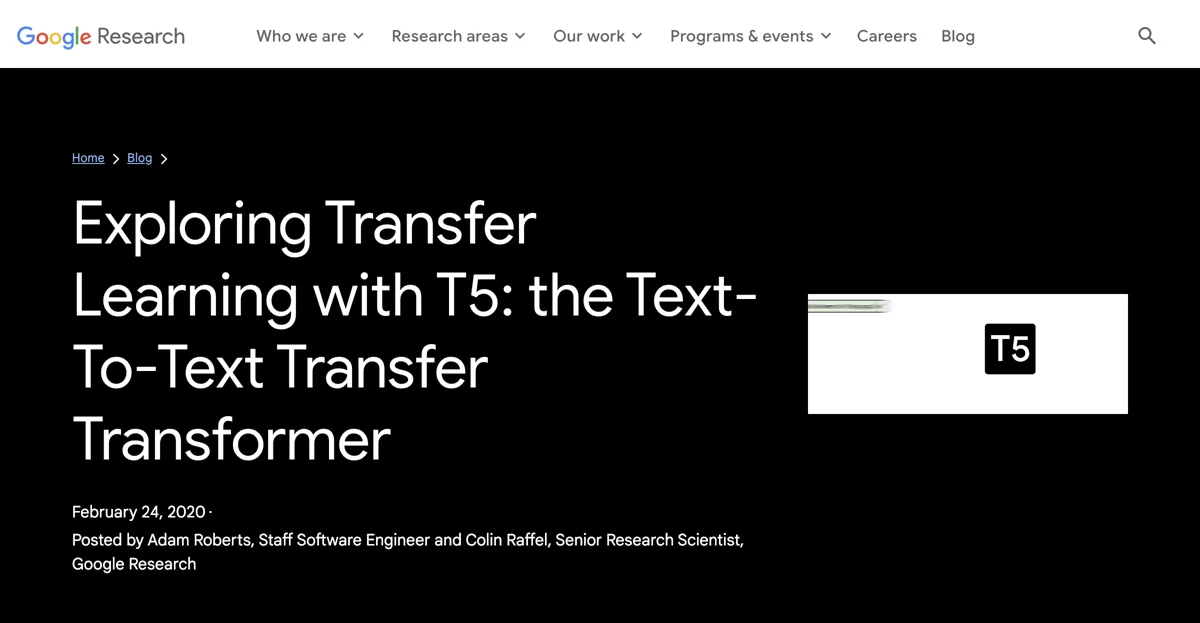The Text-To-Text Transfer Transformer (T5) is a revolutionary development in the field of natural language processing (NLP). In recent years, transfer learning has brought about a significant transformation in NLP, with models being pre-trained on abundant unlabeled text data and then fine-tuned on smaller labeled datasets for improved performance. T5 builds on this approach and presents a large-scale empirical survey to determine the most effective transfer learning techniques. It also introduces the Colossal Clean Crawled Corpus (C4), a new open-source pre-training dataset. T5's text-to-text framework is a key feature that allows it to handle a wide variety of NLP tasks, including machine translation, document summarization, question answering, and classification tasks. By framing all NLP tasks into a unified text-to-text format, T5 can use the same model, loss function, and hyperparameters, providing a consistent and efficient approach. The C4 dataset is an important component of T5's success. It is a cleaned version of Common Crawl that is two orders of magnitude larger than Wikipedia, ensuring high quality, diversity, and a large volume of data for pre-training. This helps the model to avoid overfitting and achieve better results on downstream tasks. Through a systematic study of transfer learning methodology, T5 examines various aspects such as model architectures, pre-training objectives, unlabeled datasets, training strategies, and scale. The findings show that encoder-decoder models generally outperform "decoder-only" language models, and fill-in-the-blank-style denoising objectives work best. T5 achieves state-of-the-art results on several NLP benchmarks, including GLUE, SuperGLUE, SQuAD, and CNN/Daily Mail. Notably, it achieves a near-human score on the SuperGLUE natural language understanding benchmark. T5 is also highly flexible and can be easily modified for application to many other tasks. For example, it has been successfully applied to closed-book question answering and fill-in-the-blank text generation with variable-sized blanks. In closed-book question answering, T5 is able to answer questions based on the knowledge it internalized during pre-training, without access to any external knowledge. In fill-in-the-blank text generation, T5 is able to replace a blank with a specified number of words, producing realistic outputs. Overall, T5 represents a significant advancement in the field of NLP, offering a powerful tool for a wide range of applications and opening up new possibilities for future research and development.

Text
T5 is an advanced NLP model that offers a unified text-to-text framework and achieves state-of-the-art results on multiple benchmarks.

Top Alternatives to Text
Boba
Boba is an AI-powered ideation tool that assists with research and strategy
Wiseone
Wiseone is an AI-powered tool that boosts web search and reading productivity
Project Knowledge Exploration
Project Knowledge Exploration is an AI-powered research platform that offers in-depth exploration
Runway
Runway is an AI-powered creativity tool for various media
Notably
Notably is an AI-powered research platform that boosts efficiency
PaperBrain
PaperBrain is an AI-powered research tool that simplifies access
Unriddle
Unriddle is an AI-powered research tool that saves time and simplifies tasks
Journey AI
Journey AI converts customer research into actionable journey maps
genei
genei is an AI-powered research tool that boosts productivity
Replio
Replio is an AI-powered research platform that streamlines interviews and analytics
Layer
Layer is an AI-powered research tool that saves time
Iris.ai RSpace™
Iris.ai RSpace™ is an AI-powered workspace for smarter research
Fairgen
Fairgen is an AI-powered research tool that offers granular insights
Towards Data Science
Towards Data Science offers diverse AI-related content and insights
NewsDeck
NewsDeck is an AI-powered newsreader that helps users discover, filter, and analyze thousands of articles daily.
Locus
Locus is an AI-powered smart search tool that enhances productivity by quickly finding relevant information on any web page using natural language.
Encord
Encord is an AI-powered data development platform that accelerates data curation and labeling workflows for computer vision and multimodal AI teams.
Seeker
Seeker is a secure, retrieval-augmented generation AI chat platform that provides trustworthy insights from large data sets.
AIModels.fyi
AIModels.fyi is an AI-powered platform that curates and summarizes the latest AI research papers, models, and tools, helping users stay informed about significant AI breakthroughs.
22Analytics
22Analytics is an AI-powered market research platform that helps users validate ideas and analyze competitors efficiently.
Grably
Grably offers instant access to highly-specific, labeled datasets for AI training, enhancing model accuracy with diverse real-world data.